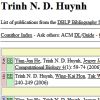|
|
|
|
|
|
|
|
| |
 
Jesper Jansson,
Konstantinos Mampentzidis,
Ramesh Rajaby and
Wing-Kin Sung. Computing the Rooted Triplet Distance Between Phylogenetic Networks. In IWOCA19, Vol. 11638:290-303 of LNCS, Springer, 2019.
Keywords: distance between networks, from network, phylogenetic network, phylogeny, polynomial, triplet distance.
|
|
|
|
|
|
| |
 
Jesper Jansson,
Ramesh Rajaby and
Wing-Kin Sung. An Efficient Algorithm for the Rooted Triplet Distance Between Galled Trees. In AlCoB17, Vol. 10252:115-126 of LNCS, Springer, 2017.
Keywords: distance between networks, from network, phylogenetic network, phylogeny, polynomial, reconstruction, triplet distance.
Note: .
|
|
|
|
|
|
| |
 
Jesper Jansson and
Andrzej Lingas. Computing the rooted triplet distance between galled trees by counting triangles. In Journal of Discrete Algorithms, Vol. 25:66-78, 2014.
Keywords: distance between networks, explicit network, from network, galled network, phylogenetic network, phylogeny, polynomial, triplet distance.
Toggle abstract
"We consider a generalization of the rooted triplet distance between two phylogenetic trees to two phylogenetic networks. We show that if each of the two given phylogenetic networks is a so-called galled tree with n leaves then the rooted triplet distance can be computed in o(n2.687) time. Our upper bound is obtained by reducing the problem of computing the rooted triplet distance between two galled trees to that of counting monochromatic and almost-monochromatic triangles in an undirected, edge-colored graph. To count different types of colored triangles in a graph efficiently, we extend an existing technique based on matrix multiplication and obtain several new algorithmic results that may be of independent interest: (i) the number of triangles in a connected, undirected, uncolored graph with m edges can be computed in o(m1.408) time; (ii) if G is a connected, undirected, edge-colored graph with n vertices and C is a subset of the set of edge colors then the number of monochromatic triangles of G with colors in C can be computed in o(n2.687) time; and (iii) if G is a connected, undirected, edge-colored graph with n vertices and R is a binary relation on the colors that is computable in O(1) time then the number of R-chromatic triangles in G can be computed in o(n2.687) time. © 2013 Elsevier B.V. All rights reserved."
|
|
|
|
|
|
| |
    
An-Chiang Chu,
Jesper Jansson,
Richard Lemence,
Alban Mancheron and
Kun-Mao Chao. Asymptotic Limits of a New Type of Maximization Recurrence with an Application to Bioinformatics. In TAMC12, Vol. 7287:177-188 of LNCS, springer, 2012.
Keywords: from triplets, galled network, level k phylogenetic network, phylogenetic network.
Note: preliminary version.
Toggle abstract
"We study the asymptotic behavior of a new type of maximization recurrence, defined as follows. Let k be a positive integer and p k(x) a polynomial of degree k satisfying p k(0) = 0. Define A 0 = 0 and for n ≥ 1, let A n = max 0≤i<n{A i+n kp k(i/n)}. We prove that lim n→∞A n/n n = sup{pk(x)/1-x k : 0≤x<1}. We also consider two closely related maximization recurrences S n and S′ n, defined as S 0 = S′ 0 = 0, and for n ≥ 1, S n = max 0≤i<n{S i + i(n-i)(n-i-1)/2} and S′ n = max 0≤i<n{S′ i + ( 3 n-i) + 2i( 2 n-i) + (n-i)( 2 i)}. We prove that lim n→∞ S′n/3( 3 n) = 2(√3-1)/3 ≈ 0.488033..., resolving an open problem from Bioinformatics about rooted triplets consistency in phylogenetic networks. © 2012 Springer-Verlag."
|
|
| |
 
Jesper Jansson and
Andrzej Lingas. Computing the rooted triplet distance between galled trees by counting triangles. In CPM12, Vol. 7354:385-398 of LNCS, springer, 2012.
Keywords: distance between networks, explicit network, from network, galled tree, phylogenetic network, phylogeny, polynomial, triplet distance.
Note: http://www.df.lth.se/~jj/Publications/d_rt_for_Galled_Trees5_CPM_2012.pdf.
Toggle abstract
"We consider a generalization of the rooted triplet distance between two phylogenetic trees to two phylogenetic networks. We show that if each of the two given phylogenetic networks is a so-called galled tree with n leaves then the rooted triplet distance can be computed in o(n 2.688) time. Our upper bound is obtained by reducing the problem of computing the rooted triplet distance to that of counting monochromatic and almost- monochromatic triangles in an undirected, edge-colored graph. To count different types of colored triangles in a graph efficiently, we extend an existing technique based on matrix multiplication and obtain several new related results that may be of independent interest. © 2012 Springer-Verlag."
|
|
| |
    
Tetsuo Asano,
Jesper Jansson,
Kunihiko Sadakane,
Ryuhei Uehara and
Gabriel Valiente. Faster computation of the Robinson–Foulds distance between phylogenetic networks. In Information Sciences, Vol. 197:77-90, 2012.
Keywords: distance between networks, explicit network, level k phylogenetic network, phylogenetic network, polynomial, spread.
Toggle abstract
"The Robinson-Foulds distance, a widely used metric for comparing phylogenetic trees, has recently been generalized to phylogenetic networks. Given two phylogenetic networks N 1, N 2 with n leaf labels and at most m nodes and e edges each, the Robinson-Foulds distance measures the number of clusters of descendant leaves not shared by N 1 and N 2. The fastest known algorithm for computing the Robinson-Foulds distance between N 1 and N 2 runs in O(me) time. In this paper, we improve the time complexity to O(ne/log n) for general phylogenetic networks and O(nm/log n) for general phylogenetic networks with bounded degree (assuming the word RAM model with a word length of ⌈logn⌉ bits), and to optimal O(m) time for leaf-outerplanar networks as well as optimal O(n) time for level-1 phylogenetic networks (that is, galled-trees). We also introduce the natural concept of the minimum spread of a phylogenetic network and show how the running time of our new algorithm depends on this parameter. As an example, we prove that the minimum spread of a level-k network is at most k + 1, which implies that for one level-1 and one level-k phylogenetic network, our algorithm runs in O((k + 1)e) time. © 2012 Elsevier Inc. All rights reserved."
|
|
|
|
|
|
| |
    
Tetsuo Asano,
Jesper Jansson,
Kunihiko Sadakane,
Ryuhei Uehara and
Gabriel Valiente. Faster Computation of the Robinson-Foulds Distance between Phylogenetic Networks. In CPM10, Vol. 6129:190-201 of LNCS, springer, 2010.
Keywords: distance between networks, explicit network, level k phylogenetic network, phylogenetic network, polynomial, spread.
Note: http://hdl.handle.net/10119/9859, slides available at http://cs.nyu.edu/parida/CPM2010/MainPage_files/18.pdf.
Toggle abstract
"The Robinson-Foulds distance, which is the most widely used metric for comparing phylogenetic trees, has recently been generalized to phylogenetic networks. Given two networks N1,N2 with n leaves, m nodes, and e edges, the Robinson-Foulds distance measures the number of clusters of descendant leaves that are not shared by N1 and N2. The fastest known algorithm for computing the Robinson-Foulds distance between those networks runs in O(m(m + e)) time. In this paper, we improve the time complexity to O(n(m+ e)/ log n) for general networks and O(nm/log n) for general networks with bounded degree, and to optimal O(m + e) time for planar phylogenetic networks and boundedlevel phylogenetic networks.We also introduce the natural concept of the minimum spread of a phylogenetic network and show how the running time of our new algorithm depends on this parameter. As an example, we prove that the minimum spread of a level-k phylogenetic network is at most k + 1, which implies that for two level-k phylogenetic networks, our algorithm runs in O((k + 1)(m + e)) time. © Springer-Verlag Berlin Heidelberg 2010."
|
|
|
|
|
|
|
|
|
|
| |
   
Ho-Leung Chan,
Jesper Jansson,
Tak-Wah Lam and
Siu-Ming Yiu. Reconstructing an Ultrametric Galled Phylogenetic Network from a Distance Matrix. In JBCB, Vol. 4(4):807-832, 2006.
Keywords: explicit network, from distances, galled tree, phylogenetic network, phylogeny, polynomial, reconstruction.
Note: http://www.df.lth.se/~jj/Publications/dist_ugn7_JBCB2006.pdf.
Toggle abstract
"Given a distance matrix M that specifies the pairwise evolutionary distances between n species, the phylogenetic tree reconstruction problem asks for an edge-weighted phylogenetic tree that satisfies M, if one exists. We study some extensions of this problem to rooted phylogenetic networks. Our main result is an O(n2 log n)-time algorithm for determining whether there is an ultrametric galled network that satisfies M, and if so, constructing one. In fact, if such an ultrametric galled network exists, our algorithm is guaranteed to construct one containing the minimum possible number of nodes with more than one parent (hybrid nodes). We also prove that finding a largest possible submatrix M′ of M such that there exists an ultrametric galled network that satisfies M′ is NP-hard. Furthermore, we show that given an incomplete distance matrix (i.e. where some matrix entries are missing), it is also NP-hard to determine whether there exists an ultrametric galled network which satisfies it. © 2006 Imperial College Press."
|
|
| |
  
Jesper Jansson,
Nguyen Bao Nguyen and
Wing-Kin Sung. Algorithms for Combining Rooted Triplets into a Galled Phylogenetic Network. In SICOMP, Vol. 35(5):1098-1121, 2006.
Keywords: approximation, explicit network, from triplets, galled tree, phylogenetic network, phylogeny, polynomial, reconstruction.
Note: http://www.df.lth.se/~jj/Publications/triplets_to_gn7_SICOMP2006.pdf.
Toggle abstract
"This paper considers the problem of determining whether a given set Τ of rooted triplets can be merged without conflicts into a galled phylogenetic network and, if so, constructing such a network. When the input Τ is dense, we solve the problem in O(|Τ|) time, which is optimal since the size of the input is Θ(|Τ|). In comparison, the previously fastest algorithm for this problem runs in O(|Τ|2) time. We also develop an optimal O(|Τ|)-time algorithm for enumerating all simple phylogenetic networks leaf-labeled by L that are consistent with Τ, where L is the set of leaf labels in Τ, which is used by our main algorithm. Next, we prove that the problem becomes NP-hard if extended to nondense inputs, even for the special case of simple phylogenetic networks. We also show that for every positive integer n, there exists some set Τ of rooted triplets on n leaves such that any galled network can be consistent with at most 0.4883 ·|Τ| of the rooted triplets in Τ. On the other hand, we provide a polynomial-time approximation algorithm that always outputs a galled network consistent with at least a factor of 5/12 (> 0.4166) of the rooted triplets in Τ. © 2006 Society for Industrial and Applied Mathematics."
|
|
| |
 
Jesper Jansson and
Wing-Kin Sung. Inferring a level-1 phylogenetic network from a dense set of rooted triplets. In TCS, Vol. 363(1):60-68, 2006.
Keywords: explicit network, from triplets, galled tree, level k phylogenetic network, phylogenetic network, phylogeny, polynomial, reconstruction.
Note: http://www.df.lth.se/~jj/Publications/ipnrt8_TCS2006.pdf.
Toggle abstract
"We consider the following problem: Given a set T of rooted triplets with leaf set L, determine whether there exists a phylogenetic network consistent with T, and if so, construct one. We show that if no restrictions are placed on the hybrid nodes in the solution, the problem is trivially solved in polynomial time by a simple sorting network-based construction. For the more interesting (and biologically more motivated) case where the solution is required to be a level-1 phylogenetic network, we present an algorithm solving the problem in O (| T |2) time when T is dense, i.e., when T contains at least one rooted triplet for each cardinality three subset of L. We also give an O (| T |5 / 3)-time algorithm for finding the set of all phylogenetic networks having a single hybrid node attached to exactly one leaf (and having no other hybrid nodes) that are consistent with a given dense set of rooted triplets. © 2006 Elsevier B.V. All rights reserved."
|
|
| |
   
Ying-Jun He,
Trinh N. D. Huynh,
Jesper Jansson and
Wing-Kin Sung. Inferring Phylogenetic Relationships Avoiding Forbidden Rooted Triplets. In JBCB, Vol. 4(1):59-74, 2006.
Note: http://www.df.lth.se/~jj/Publications/forb_triplets7_JBCB2006.pdf.
Toggle abstract
"To construct a phylogenetic tree or phylogenetic network for describing the evolutionary history of a set of species is a well-studied problem in computational biology. One previously proposed method to infer a phylogenetic tree/network for a large set of species is by merging a collection of known smaller phylogenetic trees on overlapping sets of species so that no (or as little as possible) branching information is lost. However, little work has been done so far on inferring a phylogenetic tree/network from a specified set of trees when in addition, certain evolutionary relationships among the species are known to be highly unlikely. In this paper, we consider the problem of constructing a phylogenetic tree/network which is consistent with all of the rooted triplets in a given set C and none of the rooted triplets in another given set F. Although NP-hard in the general case, we provide some efficient exact and approximation algorithms for a number of biologically meaningful variants of the problem. © Imperial College Press."
|
|
|
|
|
|
| |
   
Charles Choy,
Jesper Jansson,
Kunihiko Sadakane and
Wing-Kin Sung. Computing the maximum agreement of phylogenetic networks. In TCS, Vol. 335(1):93-107, 2005.
Keywords: dynamic programming, FPT, level k phylogenetic network, MASN, NP complete, phylogenetic network, phylogeny.
Note: http://www.df.lth.se/~jj/Publications/masn8_TCS2005.pdf.
Toggle abstract
"We introduce the maximum agreement phylogenetic subnetwork problem (MASN) for finding branching structure shared by a set of phylogenetic networks. We prove that the problem is NP-hard even if restricted to three phylogenetic networks and give an O(n2)-time algorithm for the special case of two level-1 phylogenetic networks, where n is the number of leaves in the input networks and where N is called a level-f phylogenetic network if every biconnected component in the underlying undirected graph induces a subgraph of N containing at most f nodes with indegree 2. We also show how to extend our technique to yield a polynomial-time algorithm for any two level-f phylogenetic networks N1,N2 satisfying f=O(logn); more precisely, its running time is O(|V(N1)|·|V(N2)|·2f1+f2), where V(Ni) and fi denote the set of nodes in Ni and the level of Ni, respectively, for i∈{1,2}. © 2005 Elsevier B.V. All rights reserved."
|
|
| |
|
| |
  
Jesper Jansson,
Nguyen Bao Nguyen and
Wing-Kin Sung. Algorithms for Combining Rooted Triplets into a Galled Phylogenetic Network. In SODA05, Pages 349-358, 2005.
Keywords: approximation, explicit network, from triplets, galled tree, phylogenetic network, phylogeny, polynomial, reconstruction.
Note: http://portal.acm.org/citation.cfm?id=1070481.
|
|
| |
|
| |
   
Trinh N. D. Huynh,
Jesper Jansson,
Nguyen Bao Nguyen and
Wing-Kin Sung. Constructing a Smallest Refining Galled Phylogenetic Network. In RECOMB05, Vol. 3500:265-280 of LNCS, springer, 2005.
Keywords: from rooted trees, galled tree, NP complete, phylogenetic network, phylogeny, polynomial, Program SPNet, reconstruction.
Note: http://www.df.lth.se/~jj/Publications/refining_gn3_RECOMB2005.pdf.
|
|
| |
|
|
|
|
|
| |
   
Charles Choy,
Jesper Jansson,
Kunihiko Sadakane and
Wing-Kin Sung. Computing the maximum agreement of phylogenetic networks. In Proceedings of Computing: the Tenth Australasian Theory Symposium (CATS'04), Vol. 91:134-147 of Electronic Notes in Theoretical Computer Science, 2004.
Keywords: dynamic programming, FPT, level k phylogenetic network, MASN, NP complete, phylogenetic network, phylogeny.
Note: http://www.df.lth.se/~jj/Publications/masn6_CATS2004.pdf.
Toggle abstract
"We introduce the maximum agreement phylogenetic subnetwork problem (MASN) of finding a branching structure shared by a set of phylogenetic networks. We prove that the problem is NP-hard even if restricted to three phylogenetic networks and give an O(n2)-time algorithm for the special case of two level-1 phylogenetic networks, where n is the number of leaves in the input networks and where N is called a level-f phylogenetic network if every biconnected component in the underlying undirected graph contains at most f nodes having indegree 2 in N. Our algorithm can be extended to yield a polynomial-time algorithm for two level-f phylogenetic networks N 1,N2 for any f which is upper-bounded by a constant; more precisely, its running time is O(|V(N1)|·|V(N 2)|·4f), where V(Ni) denotes the set of nodes of Ni. © 2004 Published by Elsevier B.V."
|
|
| |
 
Jesper Jansson and
Wing-Kin Sung. Inferring a level-1 phylogenetic network from a dense set of rooted triplets. In COCOON04, Vol. 3106:462-471 of LNCS, springer, 2004.
Keywords: explicit network, from triplets, galled tree, level k phylogenetic network, phylogenetic network, phylogeny, polynomial, reconstruction.
Note: http://www.df.lth.se/~jj/Publications/ipnrt6_COCOON2004.pdf.
|
|
|
|
 - forked on GitHub.
- forked on GitHub.
















